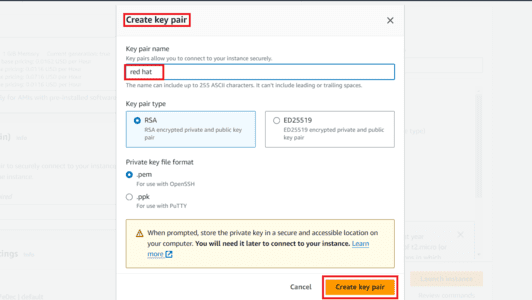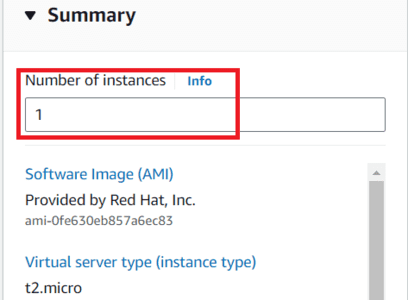How To Create Redhat EC2 Instance in AWS
Last Updated :
26 Apr, 2024
provisioning the Red Hat Enterprise Linux (RHEL) instances on Amazon Web Services (AWS) offers a powerful and versatile solution for hosting and running applications, overseeing the jobs, and utilizing the abilities of both platforms. Red Hat Enterprise Linux is a main Linux distribution eminent for its soundness, security, and enterprise-grade support, while AWS gives an adaptable and dependable distributed computing platform with a great many administrations.
In this article, we will stroll through the most common way of making a Red Hat instance on AWS utilizing the Elastic Compute Cloud (EC2) service. We’ll cover fundamental advances, for example, choosing the proper Amazon Machine image (AMI), instance storage, arranging instance settings, launching the instance, and accessing to it securely and safely. Also, we’ll examine the advantages of running a Red Hat instance on AWS and address common questions regarding costs, subscriptions, and management. with respect to expenses, memberships, and the board.
By following this guide, you’ll acquire a reasonable comprehension of how to deploy Red Hat Enterprise Linux instances on AWS, empowering you to harness the power of both platforms for your applications and infrastructure needs.
Understanding of primary terminologies:
What is RHEL?
it is one of the best Linux distributions, RHEL stands for Red Hat Enterprise Linux.
- it is a Linux-based operating system developed by Red Hat inc.
- it is designed for enterprise environments
- it provides a scalable, secure, reliable platform for running critical applications and services.
the following key points describe the RHEL highlights and its power. As a leading enterprise Linux distribution, RHEL offers a stable, secure, and scalable platform for a wide range of computing environments, including servers, workstations, and cloud deployments. It provides robust security features, long-term support, and a comprehensive ecosystem of certified hardware, software, and applications.
Key features of RHEL include:
Long-term Support:
- RHEL offers long-term support with regular security updates and bug fixes, providing stability for enterprise environment deployments.
Security:
- RHEL is a most secure and enterprise platform application deployment and incorporates robust security features to protect against cyber threats, including SELinux (Security-Enhanced Linux) for mandatory access controls and cryptographic tools for data encryption.
Reliability:
- RHEL is known for its reliability and uptime, making it suitable for hosting critical workloads and services.
AWS services:
- when we want launch Red hat instance in AWS we need to know about other aws services
- to launch the red hat instance we need to know the terminologies of AMI,instance type,key pair,security groups etc..
AMI:
- An Amazon Machine Image (AMI) is like a pre-configured operating system.
- there are many AMIs in AWS like Red Hat,ubuntu,amazonlinux,windows,suse,debian etc..
- we can launch many EC2 instances with single AMI and launch different instances.
Instance type:
an Amazon EC2, an “instance type” refers to a predefined combination of virtual CPU (vCPU), memory, storage, and networking capacity. Each instance type is optimized for specific use cases and workloads. When launching an EC2 instance, you must choose an instance type that best
The examples of ec2 instance types
- t2.nano
- t2.micro
- t3.medium
- c4.4xlarge
Key pair:
In Amazon EC2, a key pair is a secure way to connect to your instances. key pair is the combination of a public key and a private key. Here’s how key pairs work in EC2:
Create Red Hat EC2 Instance in AWS (Amazon Web Services)
Step 1: Login into aws console
- Go to the aws console management in browser and login into aws account with your aws credentials.
- in search box search for ec2
![Screenshot_2024-04-17_171752[1]](https://media.geeksforgeeks.org/wp-content/uploads/20240417172658/Screenshot_2024-04-17_171752[1].png)
Step 2: Navigate to EC2 dashboard
- navigate to the ec2 dashboard under ec2 dashboard you can see instances options select instances and click on launch instances.
ec2 dashboard>instances>Launch instances

Step 3: Choose AMI (Amazon Machine Image)
- In the “Choose an Amazon Machine Image (AMI)” step, search for “Red Hat” in the search bar and select the desired version of Red Hat Enterprise Linux.

Step 4: Select Instance Type
- Choose the instance type as you wish based on your requirements, such as CPU, memory, storage, and network performance.
- here, i select t2.micro which comes with 1vCPU and 1GiB Memory.

Step 5: Select or create Key Pair
- Choose an existing key pair or create a new key pair to securely access your instance via SSH.
- here i am going to create new key pair for my red hat instance.
- click on create new key pair.
- name your key pair as you wish i named as red hat here.


Step 6: Network settings and Configure Instance.
- in this step you can add security setting such as firewall like port numbers and storage.
- Configure additional settings such as instance details, network settings, storage, tags, and security groups according to your needs.

Step 7: Review and Launch
- Review the configuration details of your instance and click on the “Launch” button to proceed.


Step 8: Launch Instance
- Click on the “Launch Instances” button to deploy your Red Hat instance in AWS.


- select the launched instance and click on connect and connect this red hat instance through CLI.
ssh -i "keypair" ec2-user@public-IP

Red Hat Instance In AWS – FAQs
Is RHEL linux free to use or paid version?
yes,RHEL is free to use as it is a open-source.
Are there other red hat enterprise linux operating system versions available in AWS?
yes,there are other RHEL operating system versions available in AWS which are
- red hat enterprise linux 9
- red hat enterprise linux 9 with high availability
- RHEL 8 with SQL Server standard edition
Are there any additional costs associated with running Red Hat instances on AWS?
In addition to the regular AWS usage charges for EC2 instances, you may incur costs for Red Hat subscriptions if you require access to updates, patches, and support services beyond the basic functionality provided by the AMI.
How do I connect to my Red Hat instance after it’s launched?
By using CLI terminal you can connect to your red hat or linux based operating system instance using SSH (Secure Shell) with the private key pair that you specified during the instance launch process. with the command
ssh -i "keypair" ec2-user@public-IP
Share your thoughts in the comments
Please Login to comment...